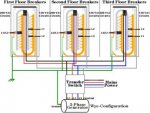Ok, first off 30KW is BIG for home use, I bought a 33KW Kohler Diesel generator for my elderly mother's house off government liquidation a few months ago (the price was right), she has a large 4,000+ SF all electric house with 3 central A/C units, well pump, electric stove/oven, etc. and does not want to think about load management. In the case of her house, it is possible for her to hit the 33KW capacity, however with just a little basic load management it is possible to have a near normal life in this energy budget (just don't try cooking with stove/oven while doing laundry, running all A/C's and taking hot showers (electric water heaters), etc. In contrast I opt for a much more minimalistic generator for my home (city water, gas heat, gas stove), currently a single 1,000 watt Honda generator, enough to run the fridge and a very small window air conditioner, I am seriously considering upgrading to a 3KW for my house, as the fridge and window A/C are pushing the limits on my little unit, still it is nice to know I can run it for 48 hours on 6 gallons of gasoline.
Now here a few generalities,One nice thing about diesels (at least those not prone to wet stacking) is a fairly linear fuel to output curve from 1/ 4 load to full load. (the above mentioned 33KW unit consumes just over 4 gal/hr at full load and just over 1 gal/hr at 1/4 load) Another advantage of diesel is the fuel cost can be 30-50% less than Natrual Gas or Propane units, also after a wide spread disaster it is likely to be easier to refuel than refuelling large propane tanks. Compared to gasoline, diesel is much safer to store, and if in a sealed drum can be stored for VERY long periods of time.
As to the 3 phase/single phase generator issue, do some research on the specific model you are considering, most 120/208 3 phase units can be reconnected for 120/240 single phase, however the majority of these will be limited to 2/3 of their total KW output in single phase connection, to keep full rated output a 3 phase 120/208 unit can run 3 balanced 120 volt legs, however this may need some special wiring (or just connect 2 legs to your standard hot legs of your home single phase, and use extension cords for the remaining 1/3), this would give you that same 2/3 useful power out of the unit, plus the other 1/3 through extension cords (or a dedicated 120 volt, single hot leg panel)
ike
p.s. many 120/240 home appliances (dryers, water heaters, Air conditioners, etc) will run on 2 legs of 120/208 3 phase, this allows the manufactuers to sell the same units to offices, etc. with 3 phase power, check to data plates to see if they read 208-230 instead of 230/240
 . I use what I have and it works fine.
. I use what I have and it works fine. wants to donate to my auto-make-it-happen-transfer-switch...I certainly shant say no.
wants to donate to my auto-make-it-happen-transfer-switch...I certainly shant say no.


